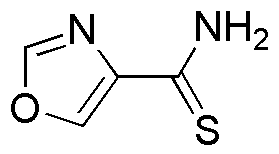Oxazole-4-carbothioic acid amide is widely utilized in research focused on:
- Pharmaceutical Development: This compound serves as a building block in the synthesis of various pharmaceuticals, particularly in the development of anti-inflammatory and antimicrobial agents.
- Agricultural Chemistry: It is used in formulating agrochemicals, enhancing crop protection products by improving their efficacy against pests and diseases.
- Material Science: The compound is explored for its potential in creating novel materials, particularly in the development of polymers with enhanced thermal and chemical stability.
- Biochemical Research: Researchers utilize it in studies related to enzyme inhibition and metabolic pathways, providing insights into biological processes and potential therapeutic targets.
- Analytical Chemistry: It acts as a reagent in various analytical techniques, aiding in the detection and quantification of other chemical compounds in complex mixtures.
General Information
Properties
Safety and Regulations
Applications
Oxazole-4-carbothioic acid amide is widely utilized in research focused on:
- Pharmaceutical Development: This compound serves as a building block in the synthesis of various pharmaceuticals, particularly in the development of anti-inflammatory and antimicrobial agents.
- Agricultural Chemistry: It is used in formulating agrochemicals, enhancing crop protection products by improving their efficacy against pests and diseases.
- Material Science: The compound is explored for its potential in creating novel materials, particularly in the development of polymers with enhanced thermal and chemical stability.
- Biochemical Research: Researchers utilize it in studies related to enzyme inhibition and metabolic pathways, providing insights into biological processes and potential therapeutic targets.
- Analytical Chemistry: It acts as a reagent in various analytical techniques, aiding in the detection and quantification of other chemical compounds in complex mixtures.
Documents
Safety Data Sheets (SDS)
The SDS provides comprehensive safety information on handling, storage, and disposal of the product.
Product Specification (PS)
The PS provides a comprehensive breakdown of the product’s properties, including chemical composition, physical state, purity, and storage requirements. It also details acceptable quality ranges and the product's intended applications.
Certificates of Analysis (COA)
Search for Certificates of Analysis (COA) by entering the products Lot Number. Lot and Batch Numbers can be found on a product’s label following the words ‘Lot’ or ‘Batch’.
*Catalog Number
*Lot Number
Certificates Of Origin (COO)
This COO confirms the country where the product was manufactured, and also details the materials and components used in it and whether it is derived from natural, synthetic, or other specific sources. This certificate may be required for customs, trade, and regulatory compliance.
*Catalog Number
*Lot Number
Safety Data Sheets (SDS)
The SDS provides comprehensive safety information on handling, storage, and disposal of the product.
DownloadProduct Specification (PS)
The PS provides a comprehensive breakdown of the product’s properties, including chemical composition, physical state, purity, and storage requirements. It also details acceptable quality ranges and the product's intended applications.
DownloadCertificates of Analysis (COA)
Search for Certificates of Analysis (COA) by entering the products Lot Number. Lot and Batch Numbers can be found on a product’s label following the words ‘Lot’ or ‘Batch’.
*Catalog Number
*Lot Number
Certificates Of Origin (COO)
This COO confirms the country where the product was manufactured, and also details the materials and components used in it and whether it is derived from natural, synthetic, or other specific sources. This certificate may be required for customs, trade, and regulatory compliance.


